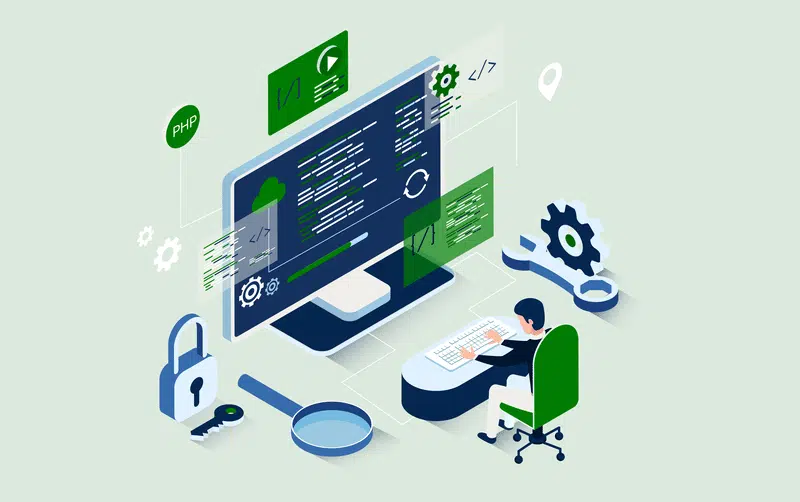Since its introduction in the year 2014, low-code development has evolved into a fundamental component of traditional development businesses. From a starting point of 44%, it now makes up 75% of the development shops.

Software development is more approachable because of low-code development, which offers a visual method for developing applications quickly. Unfortunately, many IT teams are only beginning to use low-code to its full potential. Why? due to the fact that they are managing low-code projects using conventional high-code development techniques. This article is going to provide you an insight on using Low-code to its full potential.
Approaching Low-code development:
Avoid obsolete, cumbersome development methodologies in favour of several crucial agile techniques that will hasten the development of your applications if you want to take full use of low-code. From designing solutions to structuring your teams, you need to reconsider your strategy. Small- to medium-sized businesses have recently begun to construct straightforward background services using low-code solutions in an effort to improve employee workflows.
Although creating an app is still a laborious endeavour, low-code gives the process a better overall perspective. Modern low-code development methodologies with embedded tools exist and are intended to speed up the creation of apps and greatly automate the application lifecycle. To create solutions that enhance business processes and increase profit, low-code developers use abstraction, composability, and other quick application development strategies. Making better decisions, working more efficiently, and cutting expenses all result from having access to the appropriate data at the right time.
How does low-code operate?
Low code platforms operate on a straightforward premise: they make use of graphical user interfaces and offer pre-made components with standard functionality. The very intuitive visual tools that illustrate development workflows are easier to understand than strands of code, but fundamental IT skills are still required. As a result, you can focus on what really matters: the functionality of the application you are building.
A low-code platform’s most well-known use is to facilitate the creation of straightforward applications by laypeople, like a business analytics dashboard. Low-code development technologies, however, can make skilled developers more effective with more difficult tasks.
Advantages of Low-Code Development Platforms:
The number of tools and technology that are now available to companies has increased drastically during the past 20 years. IT departments now manage different, complicated environments instead of monolithic stacks.
Nowadays, reliance on custom scripts does not match the speed and agility needed by organisations, and specialisation conflicts with the cross-platform workflows that are becoming more and more popular. Very few developers have hands-on experience with every tool used in a specific end-to-end workflow. Herein lies the role of low-code. Without having to conduct further research, write new scripts, and test them, low-code development platforms allow IT to swiftly put together new processes and construct apps.
There are primarily two sorts of low code systems: those for the industry as well as those for developers. Low-code may enable developers to create more applications in a shorter amount of time, such in weeks as opposed to months. On the other hand, low code encourages and permits business and “citizen developers” to create their apps on the industry side without the need for programming knowledge.
The following is a list of Low-code’s advantages:
- More rapid time to market
A software or a smartphone app requires a lengthy and dynamic procedure to create. On the other side, low-code platforms significantly reduce the production time.
- Significantly improved business agility
The majority of low-code development platforms are extendable, offering direct vendor interfaces and allowing IT to transform command lines, web services, and APIs into reusable building blocks. As a result, it takes less time to integrate and implement new tools and technologies, enabling organisations to keep up with emerging automation trends and customer requests.
- Regulation of access
Business users who utilise a low-code platform can quickly offer access to their applications. On a large and small scale, users can manage who has access to the software. As administrators, co-owners, or end users, users may be designated by the application’s creator.
-
Enhanced Productivity
IT is able to accomplish more in less time by streamlining the development process and expanding the usage of automation. Low-code apps can come with technologies that make the process life cycle simpler. This may involve tools for monitoring and alerting employees when a process is in danger of failing. Alternatively, if a server is at capacity, processes can be rerouted to avoid bottlenecks and delays, or remediation workflows can be carried out to uphold SLAs and reduce down on the amount of time IT spends putting out fires.
FAQs associated with Low-code development:
- Could low-code be the future?
With experts like Gartner estimating that by 2023, approximately 50% of organisations will use low-code for app development, spending $21.2 billion to create about 450 million apps, low-code is unquestionably the first step toward faster and better innovation.
- How can I become proficient in low-code?
You don’t need to be a top-tier developer to be a low-code developer. All you need is a fundamental knowledge of coding. In addition to dragging and dropping the readily available templates, this will allow you customise your app.
- Can cross-platform enterprise apps be created with low-code software?
With the help of these cross-platform app development platforms, both your staff and freelance developers can create apps that run simultaneously on Android and iOS. Citizen developers are better able to create comprehensive programmes that provide access to third-party APIs and modules for various platforms.
- Will low-code ever take the place of coding?
The answer is No. Low-code tools are designed to change and improve the process, not to eliminate the need for programmers. When the Low-code platforms take care of the rest, developers can focus on the crucial aspects of product creation.







